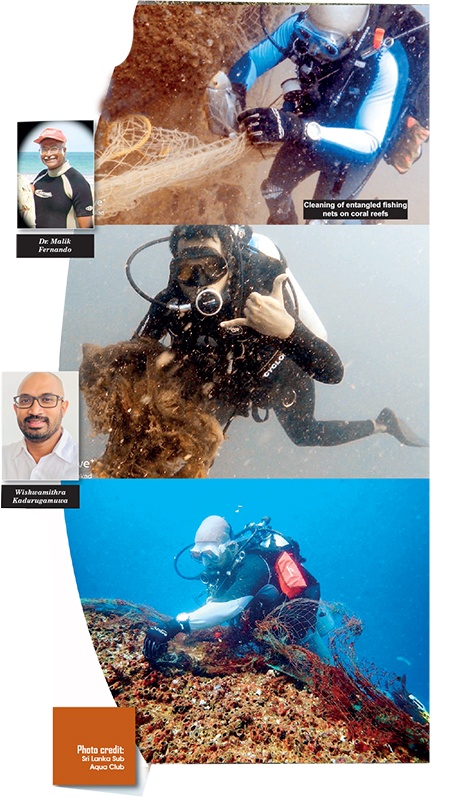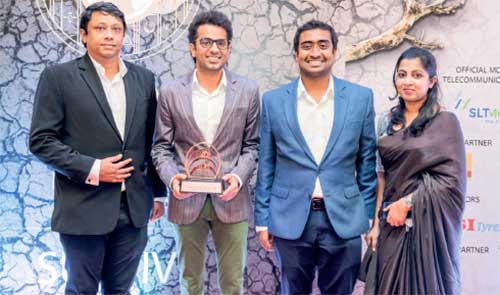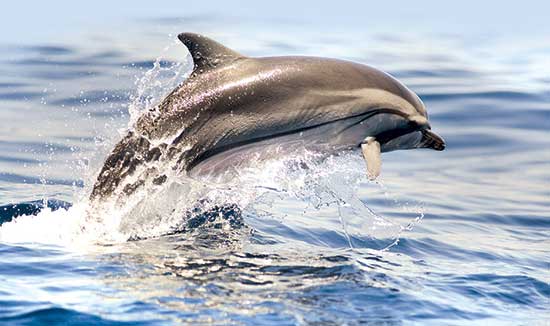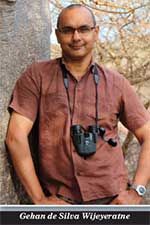Life style
A plunge of three decades and more

Sri Lanka Sub Aqua Club credited for producing some of country’s top divers, several of them internationally recognized today, turns 35
by Randima Attygalle
Piling the diving gear into their cars and filling the empty seats with fellow divers, the founder members of the Sri Lanka Sub Aqua Club (SLSAC) in its formative years would head south to Hikkaduwa or Galle. They would fill their cylinders with a compressor, cast their own lead weights from lead pipes bought in Panchikawatte and purchase second-hand equipment whenever they appeared in the market. As the Founder Chairman of the Club, veteran diver, Dr. Malik Fernando recollects more than three decades later, “those who were fortunate enough to travel abroad brought back accessories and sold them at cost and we even serviced our own regulators.”
The Sri Lanka Sub-Aqua Club was formed in 1985 by a group of diving enthusiasts led by the marine biologist, Dr. M.W.R.N de Silva (Dr. Ranjith de Silva). What was envisaged by the Club says Dr. Fernando was to train Sri Lankans in SCUBA diving for both recreation and more importantly, for scientific research. He was supported by Arjan Rajasuriya, presently the Coordinator, Coastal and Marine Programme, International Union for Conservation of Nature (IUCN) Sri Lanka Country Office. The idea of the Club germinated in the mind of the founder, Dr. Ranjith de Silva following his establishment of the Coral Unit at the National Aquatic Resources and Research Agency (NARA). The core group consisted of a few British Sub Aqua (BSAC) qualified divers such as Dr. Fernando, himself and those who have been involved in various diving-related pursuits.
The SLSAC, modelled on the BSAC, had produced several internationally reputed divers along its 35-year journey. The SLSAC-certified divers are today recognized by many local recreational dive stations. “Although we sought to form a branch of the BSAC once we got established, the cost was prohibitive, thus we initiated our independent certification scheme,” notes its founder chairman. The Club’s training courses, Dr. Fernando recollects, were very popular and many divers were trained by senior members. “However, it was eventually recognised that the BSAC curriculum was too comprehensive, too time consuming and too detailed for beginners. With the popularisation of the compact PADI course that a number of us followed, the club curriculum was modified and simplified changing from a BSAC model to a PADI model, with much less theory and drills reduced to basic essentials. The instruction was still by club members, some of whom had BSAC qualification and experience in instructing in their original clubs. We were only able to give a club certification, but after we had established our credentials by producing well trained divers, that certification came to be recognised by some of the recreational dive stations.”
The SLSAC was also one of the chief catalysts in driving the now well-established Maritime Archaelogy Unit (MAU) in Galle, and the contribution made by the Club members towards its expansion is notable. Recovery of several porcelain and glass artefacts by them from the shipwrecks lying in Galle spurred this initiative, says Dr. Fernando. Further, th

e club has also contributed to maritime archaeology and preservation of artefacts by contributing to the establishment of a shipwreck database and actively lobbying against shipwreck salvaging, especially of ancient shipwrecks.
A medical doctor, Fernando attributes his ‘physician gene’ to his illustrious father, Dr. Cyril Fernando and his penchant for nature to his artistic mother. An adventurous family, they would seize every opportunity to travel out of Colombo fuelling the budding physician-cum diver son’s exploring spirits. Taking to water at the age of seven, young Malik’s imagination was fired by the National Geographic Magazine. With a pair of flippers and a second-hand mask he would head towards Mount Lavinia and recollect his earliest experience of Hikkaduwa as “going deep down into an aquarium.” Further inspired by the celebrated diver Rodney Jonklaas, a family acquaintance as well, the freshly graduated doctor would spend more time diving than passing his higher exams in the UK!
“Today the greater accent is on tuition and passing exams with little emphasis on sports and even if children do engage in sports, it is largely for competition. Sadly the value of sports as a leisure activity and a health gain is largely undermined today,” observes Dr. Fernando who urges school authorities to take more interest in water-sports. “Learning to swim and dive is only means to an end. Not only can a person discover new places but he/she can also become a partner is conservation,” says the expert diver who has walked the talk. Encouraging the budding swimmers and divers to become partners of the marine eco-system true to the mandate of the Club, Dr. Fernando urges them to rally around it in a bid to produce ‘responsible’ divers with scientific insights.
“Diving enables connectivity with the entire eco-system from which we are sadly very detached right now. It provides one of the best windows to the polluted environment, for which man is responsible,” reflects Wishwamithra Kadurugamuwa, present President of the Club. The monthly ‘sharing of knowledge’ exercise initiated by the Club facilitates this process, he adds. The experience and stories of the experienced divers shared on this platform inspire the younger members, he says. “For us, diving is much more than sight-seeing, it is about moulding divers who would perceive things scientifically,” says Kadurugamuwa who is a corporate lawyer .
The ‘Citizen Science Project’ which was launched by the Club early this year in collaboration with the IUCN (International Union for Conservation of Nature) is a progressive move which provides the divers a portal to document their dives. The exercise is envisaged to be a vehicle of future research and a facilitator in conservation. “The end purpose of this endeavour is to have a record after each dive as to where the reefs are dying, the extent of the damage, how can they be salvaged etc. To record all this, divers need to perceive through a scientific lens for which training is provided by experts,” said Kadurugamuwa.
The opportunities within the marine eco-system which lay before an island nation such as ours are enormous, yet hardly tapped, he noted. He cites water sports and newer tourism products such as shipwreck tourism in this regard. “Sadly there is not much attention paid to the marine environment in the magnitude it ought to happen,” adding that entangled fishing nets, empty plastic bottles and yoghurt cups floating besides the coral reefs do not support the idyllic picture any underwater explorer would want to see. The Club’s intervention to clean fishing nets entangled on coral reefs and lobbying for legislation against unethical fishing practices are moves towards realizing a sustainable marine environment.
Dynamite fishing and spear-fishing are very destructive forms of fishing and whilst there is active legislation prohibiting dynamite fishing, it is practiced widely and the club has played a very active role in reporting infractions to authorities leading to curtail of such activity. In addition the club was instrumental in bringing about legislation to prohibit spear-fishing in Sri Lanka – again a very destructive practice as spear fishermen in SCUBA gear have caused localized extinction of key species.
- News Advertiesment
See Kapruka’s top selling online shopping categories such as Toys, Grocery, Flowers, Birthday Cakes, Fruits, Chocolates, Clothing and Electronics. Also see Kapruka’s unique online services such as Money Remittence,News, Courier/Delivery, Food Delivery and over 700 top brands. Also get products from Amazon & Ebay via Kapruka Gloabal Shop into Sri Lanka.
Life style
LUXASIA aims to lead luxury beauty’s growth in Sri Lanka

Sri Lanka is a land renown for stunning natural beauty. Yet, LUXASIA still managed to usher in a different kind of beautiful to the market through its expertise in luxury beauty retail and omni-distribution.
In November 2019, LUXASIA unveiled its inaugural classy beauty counters at Odel, One Galle Face. Since then, it has brought enchanting fragrances from luxury brands such as Burberry, Calvin Klein, Gucci, and Marc Jacobs, as well as trendy skincare from KORA Organics to beauty-lovers in an exquisite and captivating retail format.
Now, having successfully overcome the challenges in 2020 imposed by COVID-19 and related lockdowns, LUXASIA is ready and excited to thrill Sri Lankan consumers again. This time, it is with the launch of both skincare and make-up collections from the prestigious Japanese beauty brand, Shiseido. Arriving with a glamorously magnificent pop-up at One Galle Face from 8 to 14 February 2020, LUXASIA promises to bring memorable consumer experiences and a feast for the eyes that showcases the best in Japanese beauty.
Leading up to this pop-up, LUXASIA partnered the Key Opinion Leaders (KOLs) and top influencers of Sri Lanka to excite the beauty community with a sneak peek of what Shiseido have to offer. This campaign garnered more than 100,000 social interactions, with over 1.2 million social media impressions, piquing consumers’ fascination in Shiseido’s award-winning and best-selling serum, The Ultimune Power Infusing Concentrate.
Looking ahead into 2021, LUXASIA aims to continue delighting consumers with even more fresh retail innovations to spice up the luxury beauty scene in Sri Lanka. Soon, fragrance enthusiasts can expect a unique pop-up of all the scents that Luxasia carry, featuring new launches from Davidoff and Calvin Klein, as well as other interesting novelties. Beauty-lovers can also expect more limited edition products and gifts-with-purchases, interesting workshops, as well as seasonal offerings in the coming months. Concurrently, LUXASIA also aspires to continue grooming the Sri Lankan beauty community through more entertaining collaborations with KOLs throughout 2021.
LUXASIA sees immense potential in Sri Lanka’s fast-growing beauty market and has been its voice in the international beauty industry. For some time now, LUXASIA has been relentlessly reaching out to numerous luxury beauty brands across to world to interest them in Sri Lanka. While it is encouraging to see the first-fruits, LUXASIA is aiming much higher. Forging ahead, LUXASIA strives to champion and lead the growth of luxury beauty in Sri Lanka, through even more partnerships with great brands, and by continuously delighting consumers.
Life style
Newly published guide opens many windows on whale watching

by Ifham Nizam
Shipping lanes to the south of Dondra pose the threat of ships colliding with whales as the area has very rich marine life which also attracts whale watching boats, says prolific wildlife writer and photographer Gehan de Silva Wijeyeratne, author of the recently published ‘A Naturalist’s Guide to the Mammals of Sri Lanka’.
He says international shipping industry organizations have written to the government to push back the existing shipping lanes and if no action is initiated, there is the danger of whale watching boats colliding with vessels.
Dr. Susannah Calderon and her colleagues at the University of Ruhuna have recommended the shipping lanes be moved 15 nautical miles south. The cost impact to all concerned will be negligible, but it significantly improves safety at sea, especially at night when the sea is dotted with the lamps from hundreds of small fishing crafts in the path of giant container carriers.
“It is primarily a safety issue though an important secondary impact will be that it reduces fatal collisions with whales, while generating favourable publicity for the government of Sri Lanka. It boils down to moving the shipping lanes further south and saving lives, Wijeyeratne stressed in an interview with The Sunday Island.
Asked what’s special about his latest publication, he said: “This is the first photographic field guide which covers nearly all of the mammals found in Sri Lanka. It covers 96 per cent of the land and marine mammals. The book, which is portable and affordable, also contains a large number of images from 40 photographers which are practically useful in the field to identify  a mammal to species level. It also covers a number of small, discrete, nocturnal mammals whose existence that even many local wildlife enthusiasts will not be aware of.”
a mammal to species level. It also covers a number of small, discrete, nocturnal mammals whose existence that even many local wildlife enthusiasts will not be aware of.”
On the book’s coverage of the marine mammals, Wijeyeratne said there are two noteworthy aspects. Firstly, it covers all the species recorded in Sri Lankan waters expect for one, the Omura’s Whale. This will be included in a second edition. Secondly, it uses images of the whales and dolphins (cetaceans) which will show the animals the way a whale watcher will see them on the surface.
Artwork that shows the whole animal is important, but in field conditions, they are often of limited value to identify cetaceans which only show a little of their upper body in sections at a time they surface.
Q: You were the first to publicize that Sri Lanka was the best location for Blue Whale sightings and offered the best chance to see a superpod of Sperm Whales. Can you explain briefly how you set about branding Sri Lanka as a top international destination for whale watching?
A:
I started with field work to ascertain the facts and launched a media campaign initially with Jetwing Eco Holidays and Jetwing Hotels which was supported over many years by the Sri Lanka Tourism Promotion Bureau (SLTPB) and others in the media and tourism business. I have published 37 articles on whale watching in Sri Lanka. The first, in May 2008, was pivotal as it boldly stated that Sri Lanka was best for Blue Whales. This set everything in motion. My articles give due credit to many people who were a part of this amazing story. This includes Dr. Charles Anderson who first told me it would be feasible to see Blue Whales from the South.
A Belgian millionaire philanthropist who prefers to remain anonymous and helped create the infrastructure for whale watching by 13 tsunami affected fishing youth who set up Mirissa Water Sports and Sue Evans who was important for connecting all of us and Anoma Alagiyawadu (the Jetwing Lighthouse Naturalist) whom I tasked with collecting the initial data for the Encounter Rates I publicized in the media.
 Remarkably, no Sri Lankan marine biologist played any role in publicizing whale watching in the early years. However, soon after, they benefited by being thrust into the media spotlight by film crew researchers who had read the publicity which began with my various widely disseminated articles. Having read them, and sometimes after conversations with me, the film crews and the press came to Sri Lanka and incorporated local marine biologists into their story.
Remarkably, no Sri Lankan marine biologist played any role in publicizing whale watching in the early years. However, soon after, they benefited by being thrust into the media spotlight by film crew researchers who had read the publicity which began with my various widely disseminated articles. Having read them, and sometimes after conversations with me, the film crews and the press came to Sri Lanka and incorporated local marine biologists into their story.
At the time I broke the first story, I do not think any of the local marine biologists had even one image of a Blue Whale of a publishable standard or had any idea that Sri Lanka was the best place in the world to see Blue Whales. Hopefully, the increased profile of local marine biologists has made it easier for them to raise the funds needed for their important research.
Q: Did the Sri Lanka Tourism Promotion Bureau help your efforts with publicity and branding?
A:
Yes indeed. At the start of the publicity campaign, we produced a series of informative and attractive publications designed by Chandrika Maelge. These were printed and distributed at key consumer and travel trade fairs such as the Bird Fair, WTM and Destinations where a number of important press and tour operators were informed about Sri Lanka being a good place for whales. At some of the press drinks events in London hosted by Jetwing Eco Holidays, around 35-45 press people would attend. These events were held in collaboration with the London Office of the SLTPB.
In some years, As many as three of these press events were held allowing personal interaction with a wide pool of media people. Another important and later development is the role played by Nalin Perera who ran the SLTPB office in London for several years and attended many consumer and travel trade fairs. I had developed media briefs for him which he would print and distribute. In one conversation, he estimated that he had printed and distributed over 10,000 copies of this material.
There were others who also disseminated my stories to the international press; a notable example being Chitral Jayatilake who shared my publicity pdfs with various wildlife documentary makers he invited to Sri Lanka.
Q: Did everyone readily embrace your ideas?
It took a couple of years. I remember even into the second year of the publicity campaign there were doubts from the big companies in tourism.
I remember Srilal Miththapala who was then President of The Hotels Association of Sri Lanka speaking to me and joining a celebrity whale watching event I was leading with Shyamalee Tudawe. This was organized by Olivia Richli of the Amangalla in Galle.
Srilal wanted to report back to the association if there was any truth to the claims being made by me about how easy it was to see Blue Whales. On the coastline, the people running small guesthouses readily embraced the story as tourists who were reading my stories turned up with copies of my articles and asked for boats to take them whale watching. The international press also readily took it on as I provided credible data.
Q: What do you say to criticisms that whale watching needs better regulation?
I agree on the need for better regulation and higher standards. The tourism industry has played its part in publicizing whale watching. Other state agencies also need to step up their efforts to regulate the industry in a way that is good for the welfare of the animals and provide a good visitor experience.
Q: What do you expect ‘A Naturalist’s Guide to the Mammals of Sri Lanka’ to achieve?
I would like people to understand that there is still a lot to be discovered about Sri Lanka’s mammals and I hope this portable and affordable guide will find its way into the hands of local naturalists and inspire more research and more practical steps to conserve habitats and species.
Life style
Modern Brides and Grooms collection by LOVI Ceylon and friends

Brides and Grooms of Sri Lanka – Reimagined
“Together we’re creating moments of happiness and cherished memories for the new couple and their families” said Founder and CEO of LOVI Ceylon, Asanka de Mel, as he introduced LOVI Ceylon’s Groom collection. Each groom’s look was paired with extraordinary creations from Sri Lanka’s top bridal designers, jewelers, florists, hair and make-up artiste and was captured by story-telling photographers.
The presentation graciously hosted by the Taj Samudra and Shangri-La hotels saw 30 leading designers working hand in hand to infuse fresh ideas, celebrate cultural diversity and show-off Sri Lankan couture—the island’s hand craft heritage.
The stunning bridal costumes were painstakingly made by renowned designers Messrs. Dhananjaya Bandara, Rishard Raheem, and Michael Wijesuriya as well as Mses. Indi Yapa Abeywardena of Brides by INDI, Sonali Dharmawardena, Darshi Keerthisena of Buddhi Batiks, Ramona Oshini, Sandani Perera of IKIGAI Bridal, and Jaish Parathalingam of Aashkii. The newcomer, Ms. Anusha David also presented her couture creations under the label Gabriel.
“We want our Groom and all of the men in the wedding including the groomsmen, dads, young boys and friends, to be themselves–to feel rooted in culture, well dressed and at ease on the wedding day,” says Asanka. Celebrating the religious and cultural traditions including Buddhist, Christian, Hindu, Kandyan, Malay, Muslim, Sinhala, Tamil and western traditions of the island LOVI Ceylon’s Grooms’ range presented modern sarongs paired with formal shirts, jackets, kurtas and more. They were paired with sarees, dresses, lehengas, pant suits and an array of breathtaking outfits. There were many looks offered for the Sri Lankan diaspora, as well as couples seeking inspiration for destination weddings.
As the designs progressed from sketch to stitching, our jewelry partners Careems, Lalitha, Mallika Hemachandra, Tiesh and Vogue jewelers added their brilliant sparkles with handcrafted fine jewelry made of precious metals encrusted with diamonds, sapphires and rubies. And what wedding would be complete without flowers? Bringing the latest floral creations were florists Designer Flowers, Flowers by Joan and Karen Forbes, Lassana Flora, and Supreme Flora who made the spectacular bridal outfits blossom with their creations.
Breathing life into these wonderful creations with superb hair and make-up was anchor of the shoot, Ms. Nadiya Fernando and her collaborator Omesh, while Ramani Fernando Salons, Shane Perera, Viran Peter, Brides by Leena and Talia designs, also worked magic on the models.
The father son duo Dinuka and Dineth Fonseka of Studio3000 took on the herculean task of capturing all the creations as the anchor photography partner. The works of Ashene Bernard, Amarante Studio, Geeshan Bandara, and Portrait Culture were also presented in imaginative and artistic captures.
De Mel expressed his thanks to the wonderful models who brought the visions and fancies of the designers to life, as well as poet and author Ashok Ferrey for being the MC of the shoot and providing an eloquent commentary, delivered with his inimitable panache!
“We have world class craftsmanship here, it’s fun to work with so many experts, who just happen to be friends, to present a beautiful collection that could nudge the course of Sri Lankan clothing identity” said Asanka when asked about the work that went into this.
As he rightly reminded the gentlemen to choose wisely, “on that special wedding day, when all eyes are on her–her eyes are on you!”









